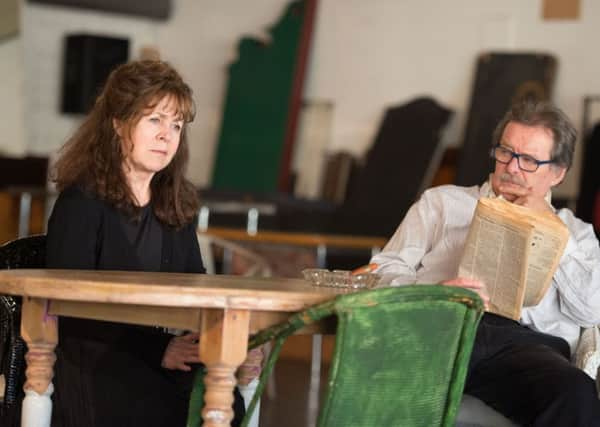Theatre preview: Long Day's Journey Into Night at the Citizens' Theatre, Glasgow


O’Neill himself saw the play as so profoundly autobiographical that he did not want to see it performed, at least until after his death; it first appeared in Sweden in 1956, and in O’Neill’s home city of New York later that year. And it’s that sense of a complete life contained in a single play, with all its rich interweaving themes, that attracted the Citizens’ director Dominic Hill to it, as the theatre’s final major in-house production before it moves out of the Citizens’ for two years, to make way for the theatre’s massive £20 million rebuilding project.
“I wanted my last show here before the move to be a big piece of meaty classical drama,” says Hill, after a long day’s rehearsal at the Citizens’, “and when it all came together for us to create another co-production with HOME Manchester – after our success with Endgame in 2016 – Long Day’s Journey emerged as our top choice.
Advertisement
Hide Ad“And although outwardly Long Day’s Journey is a very tightly-focused, classically-structured family drama – with just four main characters, and the whole action set in one room, within a single day – it’s also a play that speaks hard, radical truths about how families can tear themselves apart even when they love one another. O’Neill was a great experimentalist with theatrical form in his earlier career, and in a sense, this play is a tragedy without a single protagonist; all four members of the family have their own tragic story, and I think that’s one reason why the play is so long – it’s essentially four tragedies in one show.”
Long Day’s Journey Into Night famously tells the story of the Tyrone family, and of how they spend a long day in the late summer of 1912, at their seaside cottage in Connecticut. The father, James, is a famous if slightly fading actor who was once a penniless migrant from Ireland. His wife Mary was a gentle convent girl and gifted pianist when she met him, and has never adapted well to the harshness of an actor’s life on the road. Their sons, Jamie and Edmund have their own problems, involving addiction, illness, and their problematic relations with both parents; and the Irish actress Bríd Ní Neachtain, who plays Mary in Hill’s production, says the play makes extraordinary demands on actors, both emotionally and physically.
“It is exhausting to work on, in some ways,” she says. “It has to be. But what a courageous piece of writing, and what a catharsis it achieves. I see Mary Tyrone as a just a tremendously sad, lonely woman, who has probably led a very sheltered early life.
“Then she meets this man – this gorgeous matinee idol – and falls in love, and marries him without the slightest idea of the reality of life on the road, or of the fundamental selfishness of an actor. She loses her second child as a baby, increasingly she needs an escape – and that’s what leads to the morphine addiction that is one of the main drivers of the play, and increasingly dominates her life. She’s just trying to get through the day, and to put on a show of normality and happiness – but everyone knows what’s really going on, and eventually the whole pretence begins to fall apart.”
Hill says that it made sense to him to look to Ireland when casting Long Day’s Journey, since the play is both a great American tragedy, and a play about the huge tensions and pressures, hopes and dreams, of the Irish immigrant experience in the United States. Neachtain, though, sees it primarily as a universal drama about family dynamics, and the “pull and push and struggle” of family life; and it’s a perception she shares with the young Scottish actor, Lorn Macdonald, who won the part of Edmund in Long Day’s Journey after his brilliant appearance as Renton in Gareth Nicholls’ recent Citizens’ version of Trainspotting.
“It’s interesting that the two plays share this theme of addiction and its impact,” says Macdonald, “and addiction is always about a need to escape. With Edmund, though, what I’m focusing on is his experience of escaping from the family – he’s been away at sea for several years, and has seen and experienced so many places – and then coming back again, into this claustrophobic situation.
Advertisement
Hide Ad“So do I see Edmund as the protagonist? I think I do – maybe you have to, to play these characters. He’s the only one who has a major scene with all four of the other characters, including the young housekeeper, Cathleen, and he is the one who is almost always on stage. And of course, yes, he is the one who represents O’Neill himself, although interestingly, O’Neill gives Edmund the name of his real-life elder brother who died as a baby, and uses his own name for the fictional dead child. So that’s just another strand of mystery and meaning in the play; and although it’s set in 1912, and was written in the early 1940s, the characters contradict and baffle and overlap one another in ways that seem completely contemporary to me, and I think audiences will identify with completely – or at any rate, we hope they will.”
Long Day’s Journey Into Night is at the Citizens’ Theatre, Glasgow, until 5 May, and in Manchester from 10 May